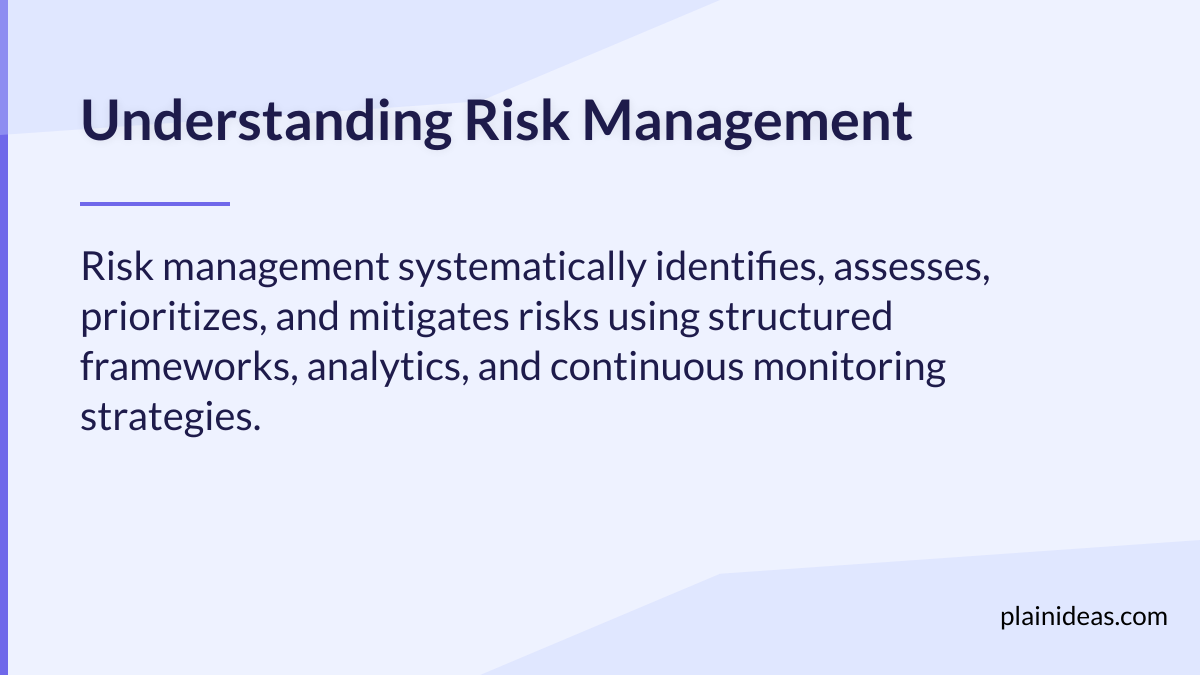Risk Management: Definition & Examples
What is Risk Management?
Risk management is the systematic identification, assessment, prioritization, and mitigation of risks that threaten organizational objectives. It involves proactively analyzing potential threats and opportunities, quantifying impacts and probabilities, and deploying controls aligned with organizational risk appetite.
Key Insights
- Effective risk management integrates risk assessment outcomes into strategic and operational decision-making processes.
- Quantifying risk exposure enables prioritization and efficient allocation of resources to critical risks.
- Continuous monitoring and review enable timely adaptation in response to shifting internal dynamics or external environments.

Risk management employs structured frameworks such as ISO 31000 or COSO ERM to standardize identification, analysis, and response procedures. Organizations leverage metrics including Value at Risk (VaR), risk heat maps, and Key Risk Indicators (KRIs) to quantify and track risk exposure. By embedding risk practices into governance structures and daily operations, organizations enhance their capacity to anticipate potential disruptions, align risk-taking with strategic objectives, and foster informed decision-making.
When it is used
Organizations apply risk management throughout various stages:
- Project planning: Evaluating if budget, schedule, or resource limitations might derail outcomes.
- Product development: Identifying potential issues in design, manufacturing, or market acceptance.
- Investment decisions: Assessing market volatility, credit risk, or economic factors.
- Operational processes: Ensuring continuity in supply chain, data security, or regulatory compliance.
Individuals also practice risk management unconsciously in daily decisions—like buying insurance or checking traffic before crossing the street—but in a business setting, the process is formalized through structured frameworks, documentation, and analytic tools.
Step-by-step framework
A typical risk management cycle involves five core steps:
- Identify risk: List potential events or conditions that could impact objectives.
- Assess probability and impact: Estimate how likely each risk is, and what consequence it could have.
- Prioritize: Rank risks based on their likelihood and potential damage.
- Plan responses: Decide how to address each risk—options include avoiding the risk, reducing its likelihood or impact, transferring it (e.g., through insurance or contracts), or accepting it by preparing contingency strategies.
- Monitor and review: Continuously track identified risks and remain vigilant for new risks, adjusting strategy and practices as conditions evolve.
Here’s a flowchart representing this cycle:
Financial risk management
Financial risk management safeguards an organization’s financial assets from adverse market fluctuations, credit issues, liquidity challenges, or operational disruptions. Organizations implementing robust financial risk management are better equipped to withstand market turbulence and leverage opportunities effectively. It addresses multiple dimensions:
Types of financial risk
- Market risk: This involves fluctuations in asset prices, interest rates, commodity prices, and currency exchange rates, all of which can dramatically impact an organization's position.
- Credit risk: Represents the potential loss stemming from borrowers or counterparties failing to fulfill their financial obligations, potentially leading to severe financial losses.
- Liquidity risk: Relates to not being able to swiftly convert assets into cash without significant financial loss, thereby potentially jeopardizing operational stability or solvency.
- Operational risk: Arises from internal system failures, human errors, or external events, influencing financial stability or causing unexpected losses.
Portfolio Value at Risk (VaR) calculation example
Imagine a bank managing a $100 million investment portfolio. To quantify the potential loss within one trading day, the risk management team uses the Value at Risk (VaR) model. Using historical market data, they determine the portfolio’s standard deviation and select a Z-score according to their desired confidence level (e.g., 95%, corresponding to approximately 1.65).
The simplified VaR formula:
VaR = Portfolio Value x Z-score x Standard Deviation
If the calculated VaR is $5 million at a 95% confidence level, this figure indicates there's a 5% probability that the portfolio could lose more than $5 million in a single day due to extreme market conditions. This analysis guides crucial decisions about maintaining sufficient capital reserves and deploying hedging strategies.
Origins
Modern risk management emerged in the mid-20th century as corporations increasingly applied statistical methods initially used in insurance and finance to broader business contexts. Over time, risk management methodologies expanded to encompass operational, strategic, and reputation risks. International standards, such as ISO 31000, now provide widely accepted best practices for systematically managing risks. Meanwhile, frameworks developed by groups such as COSO reinforce integrated, enterprise-wide approaches suitable for global enterprises and smaller organizations alike.
FAQ
Is risk management only for large corporations?
Risk management is valuable for all kinds of entities—not just large businesses. Small enterprises, startups, nonprofits, and even individuals gain substantial reassurance and strategic clarity from thoughtfully evaluating potential threats and proactively planning for contingencies. Effective risk management helps smaller entities optimize their limited resources, reduces uncertainty, and enhances decision-making capabilities to drive sustainable growth.
How do organizations determine their "risk appetite"?
Organizations establish their risk appetite based on a detailed evaluation of how much risk they can effectively manage financially, strategically, and operationally. The process typically involves senior leadership and governing boards defining acceptable limits of risk exposure in various areas (financial, operational, reputational), in line with strategic goals, financial resilience, regulatory requirements, and stakeholder expectations. Clearly communicated risk appetite statements then guide day-to-day and strategic decisions throughout the organization.
Do we need separate risk managers?
Larger organizations usually employ dedicated risk managers or even entire risk management departments, given the complexity and scope of their operations. Specialized roles may include Chief Risk Officer (CRO), who coordinates enterprise-wide strategy and compliance. For smaller teams or entities, a designated person or a combination of existing roles can assume responsibility for risk-related tasks. Regardless of size, appointing clear ownership of risk management ensures consistent oversight, accountability, and aligns risk strategy with organizational objectives.
End note
Managing risk is not about eliminating every potential threat; it's about thoughtfully understanding vulnerabilities and proactively preparing for them. For stakeholders and organizations alike, effective risk management safeguards critical resources, fosters informed and strategic decision-making, and ultimately lays the foundation for resilient, sustainable growth.